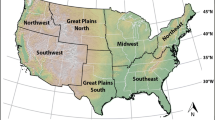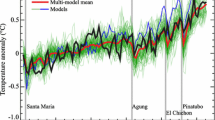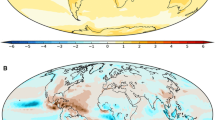Abstract
A number of uncertainties exist in climate simulation because the results of climate models are influenced by factors such as their dynamic framework, physical processes, initial and driving fields, and horizontal and vertical resolution. The uncertainties of the model results may be reduced, and the credibility can be improved by employing multi-model ensembles. In this paper, multi-model ensemble results using 10-year simulations of five regional climate models (RCMs) from December 1988 to November 1998 over Asia are presented and compared. The simulation results are derived from phase II of the Regional Climate Model Inter-comparison Project (RMIP) for Asia. Using the methods of the arithmetic mean, the weighted mean, multivariate linear regression, and singular value decomposition, the ensembles for temperature, precipitation, and sea level pressure are carried out. The results show that the multi-RCM ensembles outperform the single RCMs in many aspects. Among the four ensemble methods used, the multivariate linear regression, based on the minimization of the root mean square errors, significantly improved the ensemble results. With regard to the spatial distribution of the mean climate, the ensemble result for temperature was better than that for precipitation. With an increasing number of models used in the ensembles, the ensemble results were more accurate. Therefore, a multi-model ensemble is an efficient approach to improve the results of regional climate simulations.










Similar content being viewed by others
References
Casanova S, Ahrens B (2009) On the weighting of multimodel ensembles in seasonal and short-range weather forecasting. Mon Wea Rev 137:3811–3822. doi:10.1175/2009MWR2893.1
Chaves RR, Ross RS, Krishnamurti TN (2005) Weather and seasonal climate prediction for South America using a multi-model superensemble. Int J Climatol 25:1881–1914
Christensen JH, Machenhauer B, Jones RG et al (1997) Validation of present-day regional climate simulations over Europe: LAM simulations with observed boundary conditions. Clim Dyn 13:489–506
Dickinson RE, Errico RM, Giorgi F, Bates GT (1989) A regional climate model for the western United States. Clim Change 15:383–422
Doblas-Reyes FJ, Hagedorn R, Parmer TN (2005) The rationale behind the success of multi-model ensembles in seasonal forecasting–II. Calibration and combination. Tellus 57A:234–252
Epstein E (1969) Stochastic dynamic prediction. Tellus 21:739–759
Feng JM, Fu CB (2006) Inter-comparison of 10-year precipitation simulated by several RCMs for Asia. Adv Atmos Sci 23(4):531–542
Fu CB, Zeng ZM (1998) Monsoon regions: the highest rate of precipitation changes observed from global data. Chin Sci Bull 43:662–666
Fu CB, Wei HL, Qian Y (2000) Documentation on a regional integrated environment model system (RIEMS version 1), TEACOM Science Report No.1, START Regional Committee for Temperate East Asia, Beijing, China, pp 26
Fu CB, Wang SY, Xiong Z, Gutowski WJ, Lee DK, McGregor JL, Sato Y, Kato H, Kim JW, Suh MS (2005) Regional climate model intercomparison project for Asia. Bull Am Meteorol Soc 86:257–266
Giorgi F (1990) Simulation of regional climate using a limited area model nested in general circulation model. J Clim 2(3):941–963
Kang I-S, Yoo JH (2006) Examination of multi-model ensemble seasonal prediction methods using a simple climate system. Clim Dyn 26:285–294
Kato H, Nishizawa K, Hirakuchi H et al (2001) Performance of RegCM2.5/NCAR-CSM nested system for the simulation of climate change in East Asia caused by global warming. J Meteor Soc Jpn 79:99–121
Kharin VV, Zwiers FW (2002) Climate predictions with multimodel ensembles. J Clim 15:793–799
Krishnamurti TN, Kishtawal CM, LaRow T et al (1999) Improved weather and seasonal climate forecasts from multimodel superensemble. Science 285:1548–1550
Krishnamurti TN, Kishtawal CM, Zhang Z et al (2000) Multimodel ensemble forecasts for weather and seasonal climate. J Clim 13:4196–4216
Lacis AA, Hansen JE (1974) A parameterization for the absorption of solar radiation in the earth’s atmosphere. J Atmos Sci 31:118–133
Lee DK, Kang HS (1999) Coupling of the NCAR/LSM into the MM5 and its application for the East Asian summer monsoon. Preprints, Ninth PSU/NCAR Mesoscale Model Users, Workshop, Boulder, CO, NCAR, 198–201
Leith CE (1974) Theoretical skill of Monte Carlo forecast. Mon Wea Rev 102:409–418
Lorenz EN (1963) Deterministic non-periodic flow. J Atmos Sci 20:130–141
Mabuchi K, Sato Y, Kida H, Saigusa N, Oikawa T (1997) A Biosphere-Atmosphere Interaction Model (BAIM) and its primary verifications using grassland data. Meteor Geophys 47:115–140
Mabuchi K, Sato Y, Kida H (2002) Verification of the climatic features of a regional climate model with BAIM. J Meteor Soc Jpn 80:621–644
McGregor JL (1996) Semi-Lagrangian advection on conformal-cubic grids. Mon Wea Rev 124:1311–1322
McGregor LJ, Katzfey JJ (1998) Simulating typhoon recurvature with a variable resolution conformal-cubic model. Research activities in atmospheric and oceanic modeling, WMO/TD-No.942, 3.19-3.20
Mellor GL, Yamada T (1974) A hierarchy of turbulent closure models for planetary boundary layers. J Atmos Sci 31:1791–1806
Palmer TN, Alessandri A, Andersen U et al (2004) Development of a European Multimodel Ensemble System for Seasonal-to-Interannual Prediction (DEMETER). Bull Am Meteorol Soc 85:853–872
Peng P, Kumar A, van den Dool H (2002) An analysis of multimodel ensemble predictions for seasonal climate anomalies. J Geophys Res 107:4710. doi:10.1029/2002JD002712
Sugi M, Kuma K, Tada K, Tamiya K, Hasegawa N, Iwasaki T, Yamada S, Kitade T (1990) Description and performance of the JMA operational global spectral model (JMA-GSM89). Geophys Mag 43:105–130
Takle ES, Gutowski WJ, Arritt RW et al (1999) Project to Intercompare Regional Climate Simulations (PIRCS): description and initial results. J Geophys Res 104:19443–19462
Tang JP, Su BK, Zhao M et al (2004) Long term climate change numerical simulation in east Asia. Acta Meteorol Sin (in Chinese) 62(6):752–763
Xiong Z, Wang SY, Zeng ZM, Fu CB (2003) Analysis of simulated heavy rain over the Yangtze river valley during 11–30 June 1998 using RIEMS. Adv Atmos Sci 20:815–824
Yun WT, Stefanova L, Krishnamurti TN (2003) Improvement of the multimodel superensemble technique for seasonal forecasts. J Clim 16:3834–3840
Yun WT, Stefanova L, Mitra AK et al (2005) A Multi-model Superensemble algorithm for seasonal climate prediction using DEMETER forecasts. Tellus 57A:280–289
Acknowledgments
This work was supported by the National Key Program for Developing Basic Sciences of China (2009CB723904) and the General Project of the National Natural Science Foundation of China (40975048). We thank all participants of RMIP for their efforts in conducting the model simulations and data collection.
Author information
Authors and Affiliations
Corresponding author
Rights and permissions
About this article
Cite this article
Feng, J., Lee, DK., Fu, C. et al. Comparison of four ensemble methods combining regional climate simulations over Asia. Meteorol Atmos Phys 111, 41–53 (2011). https://doi.org/10.1007/s00703-010-0115-7
Received:
Accepted:
Published:
Issue Date:
DOI: https://doi.org/10.1007/s00703-010-0115-7




